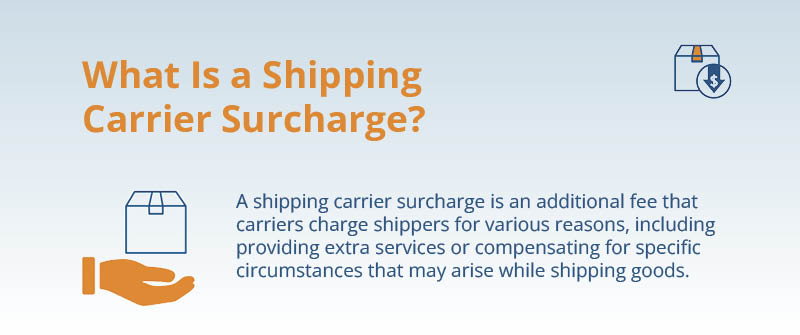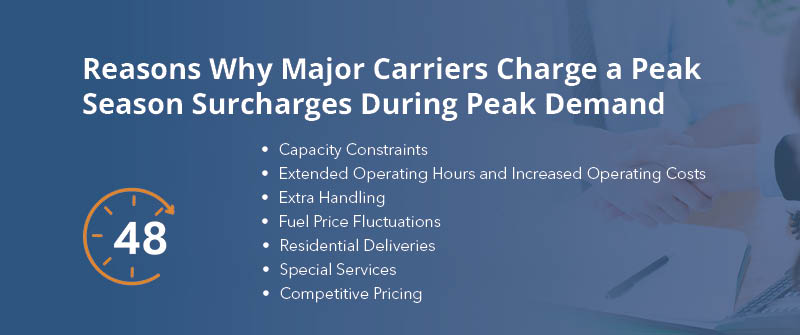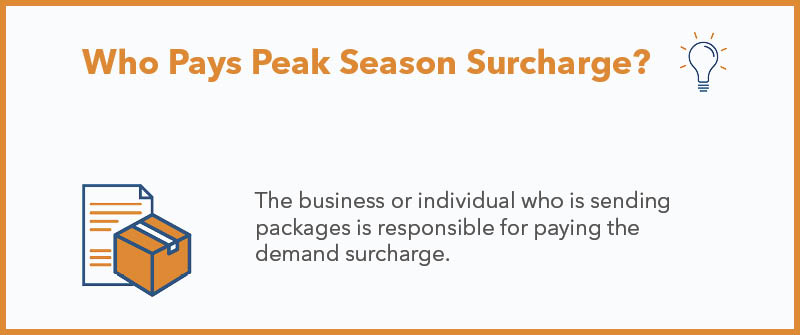What Is A Peak Season Surcharge In Shipping?
September 15, 2023 •Chase Flashman

As a business owner, peak seasons are always welcome because they bring increased sales. However, such periods can also come with higher costs and accessorial fees in shipping.
In this blog, we'll explore demand surcharges – those extra expenses that impact your bottom line during busy times. Learn what they are, when they occur, who pays, and how to manage them for a successful peak season.
Note: As of Sept. 4, 2023, FedEx stopped using the term "peak” and replaced it with "demand." Therefore, FedEx peak surcharges are now referred to as demand surcharges.
What Is a Shipping Carrier Surcharge?
A shipping carrier surcharge is an additional fee that carriers charge shippers for various reasons, including providing extra services or compensating for specific circumstances that may arise while shipping goods.
Examples of shipping carrier surcharges include:
- Delivery Area Surcharge: This fee applies when a shipment is delivered to an area that is considered remote or less accessible. Carriers may charge this to cover the added time and effort required for such deliveries.
- Fuel Surcharges: Since fuel prices are subject to frequent changes, shipping carriers may charge this fee to compensate for the fluctuations.
- Demand Surcharge: During busy holiday seasons or peak shipping periods, carriers may impose demand surcharges to manage the increased demand and strain on their supply chain. This is the topic for this article.

What Is the Difference Between Shipping Cost and Shipping Surcharge?
Shipping cost and shipping surcharge are two components that contribute to the overall cost of shipping items.
Shipping cost is the standard fee that a carrier charges to transport a package from origin to destination. This cost covers the basic activities of shipping, including pickup, sorting, delivery, and sometimes redelivery. Shipping cost is usually calculated based on factors like package size, weight, shipping speed, and the distance the package needs to travel. Shipping costs are the core charges for sending packages; other charges may or may not be added on top of it.
On the other hand, a shipping surcharge is an additional fee that carriers may impose under specific circumstances. These surcharges are typically applied to compensate for challenges, such as address corrections and oversized packages. Alternatively, they can be charged to provide supplementary services, such as residential deliveries and signature confirmation upon delivery.
What Is a Seasonal Shipping Carrier Surcharge?
A seasonal shipping carrier surcharge is a surcharge that is only applied during certain periods of the year or specific timeframes when shipping demand is significantly higher than usual. These surcharges are intended to offset the carrier's increased costs and logistical complexities associated with handling shipments during these peak seasons.
Why Do Major Carriers Charge Peak Season Shipping Surcharges During Peak Demand?
- Capacity Constraints - Due to unprecedented demand, carriers may reach their operational capacity during peak seasons. Therefore, they may need to pay for additional labor, equipment, and resources.
- Extended Operating Hours and Increased Operating Costs - To meet the demands of peak seasons, carriers often need to work longer hours, hire temporary staff, and provide overtime pay to their employees, all of which increase their operational costs.
- Extra Handling - During holidays and special occasions, packages may require extra handling, including extra care, gift wrapping, and special packaging. This may increase costs.
- Fuel Price Fluctuations - Seasonal surcharges can also account for fluctuations in fuel prices, as carriers need to adjust their pricing to cover the increased cost of fuel during certain times of the year.
- Residential Deliveries - During peak seasons like holidays, most shipments are destined for residential addresses, which can be more time-consuming and costly to deliver to compared to commercial locations.
- Special Services - Carriers often need to provide additional services during peak seasons, such as weekend deliveries or same-day deliveries, which can incur extra expenses, especially when done on a large scale.
- Competitive Pricing - Some carriers use peak season charges as a way to balance their pricing models. They may offer lower base rates throughout the year and then apply surcharges during peak seasons to align their costs with revenue.

What Is Peak Season Surcharge in the USA?
A demand charge in the USA is an additional fee carriers implement to cover extra services or address specific challenges that arise during shipping when there's high demand. These shipping peak seasons are typically holidays but can also be other events like back-to-school season or wedding season.
What Is Peak Season Surcharge FedEx?
In preparation for high demand during the holiday shipping season, on Aug. 29, 2023, FedEx updated their Express and Ground Demand Surcharges as shown in the table below.
Below is a table with updated FedEx demand surcharge 2023 dates and prices.
FedEx Demand Surcharges for Domestic U.S. Services
|
Surcharge name |
Applicable services |
2022 Surcharge amount (Oct. 2022–Jan. 2023) |
2023 Surcharge amount (Oct. 2023–Jan. 2024) |
Percentage % Increase |
|
Demand — Additional Handling Surcharge |
U.S. Express Package Services, U.S. Ground Services, International Ground Service |
$6.55 per package |
$6.95 per package |
6.11% |
|
Demand — Oversize Charge |
U.S. Express Package Services, U.S. Ground Services, International Ground Service |
$68.75 per package |
$73 per package (Oct. 2, 2023–Jan. 14, 2024) |
6.18% |
|
Demand — Ground Unauthorized Package Charge |
U.S. Ground Services, International Ground Service |
$385 per package (Oct. 3, 2022–Jan. 15, 2023) |
$410 per package (Oct. 2, 2023–Jan. 14, 2024) |
6.5% |
|
Demand Surcharge |
FedEx Ground Economy Package Services |
$1.50 per package (Oct. 31, 2022–Nov. 27, 2022) |
$1.60 per package (Oct. 30, 2023–Nov. 26, 2023) |
6.7% |
|
$2.50 per package (Nov. 28, 2022–Dec. 11, 2022) |
$2.60 per package (Nov. 27, 2023–Dec. 10, 2023) |
4.0% |
||
|
$1.50 per package (Dec. 12, 2022–Jan. 15, 2023) |
$1.60 per package (Dec. 11, 2023–Jan. 14, 2024) |
6.7% |
||
|
Demand — Residential Delivery Charge |
FedEx Express |
$2.25 – $7.00 (Oct. 31, 2022–Jan. 15, 2023) |
$2.40 – $7.40 (Oct. 30, 2023–Jan. 14, 2024) |
6.2% |
|
FedEx Ground U.S. domestic residential packages (excluding FedEx Ground Economy, and FedEx One Rate packages). |
$1.25 – $6.00 (Oct. 31, 2022–Jan. 15, 2023) |
$1.35 – $6.35 (Oct. 30, 2023–Jan. 14, 2024) |
6.9% |
More Info About the Demand — Residential Delivery Charge
This surcharge is not a fixed price but changes dynamically every week depending on the customer’s shipping volume.
“Calculation week” is the week during which customer’s shipping volume is calculated. “Application week” is the week during which the surcharge is applied based on the corresponding calculation week. Each calculation week involves determining the customer's shipping volume and peaking factor using the formula provided below. This calculation is used to determine the surcharge amount for the corresponding application week. There will be a two-week delay between the calculation of shipping activity and the application of the surcharge.

*excludes FedEx One Rate packages
Notes:
- Peaking factor and surcharge amount are calculated separately for FedEx Express and FedEx Ground.
- When a calculation week includes a holiday, adjust the weekly package volume by multiplying it by 5 and then dividing by 4 to account for the one less operating day.
The peaking factor is used to determine the surcharge rate from the table below.
|
Demand — Residential Delivery Charge per Package by Peaking Factor |
||||||
|
>105%–125% |
>125%–150% |
>150%–200% |
>200%–300% |
>300–400% |
>400% |
|
|
FedEx Ground |
$1.35 |
$1.85 |
$2.10 |
$2.65 |
$4.50 |
$6.35 |
|
FedEx Express |
$2.40 |
$2.90 |
$3.15 |
$3.70 |
$5.55 |
$7.40 |
The surcharge amount calculated during a Calculation Week will be applied to the shipper in the corresponding Application Week, which occurs two weeks later, as outlined in the table below.
|
Peaking period |
Calculation Week |
Application Week |
||
|
1 |
October 9, 2023 |
October 15, 2023 |
October 30, 2023 |
November 5, 2023 |
|
2 |
October 16, 2023 |
October 22, 2023 |
November 6, 2023 |
November 12, 2023 |
|
3 |
October 23, 2023 |
October 29, 2023 |
November 13, 2023 |
November 19, 2023 |
|
4 |
October 30, 2023 |
November 5, 2023 |
November 20, 2023 |
November 26, 2023 |
|
5 |
November 6, 2023 |
November 12, 2023 |
November 27, 2023 |
December 3, 2023 |
|
6 |
November 13, 2023 |
November 19, 2023 |
December 4, 2023 |
December 10, 2023 |
|
7 |
November 20, 2023 |
November 26, 2023 |
December 11, 2023 |
December 17, 2023 |
|
8 |
November 27, 2023 |
December 3, 2023 |
December 18, 2023 |
December 24, 2023 |
|
9 |
December 4, 2023 |
December 10, 2023 |
December 25, 2023 |
December 31, 2023 |
|
10 |
December 11, 2023 |
December 17, 2023 |
January 1, 2024 |
January 7, 2024 |
|
11 |
December 18, 2023 |
December 24, 2023 |
January 8, 2024 |
January 14, 2024 |
For example if a customer’s peaking factor for FedEx Ground in the week Oct. 9, 2023–Oct. 15, 2023 was 152%, the surcharge amount will be $2.10. That surcharge will be applied to his shipping volume in the week of Oct. 30, 2023–Nov. 5, 2023.
For further details, visit the FedEx demand surcharges page.
What Is Peak Season Surcharge UPS?
UPS just released its demand surcharge 2023 update.
Below is the UPS peak surcharges list for domestic services, along with demand surcharge UPS dates.
A. Demand Surcharge – Applied to Additional Handling and Large Packages
|
Surcharge |
Current Surcharge amount (Jan. 15, 2023–Sep. 30, 2023) |
New Surcharge amount (Oct. 1, 2023–Jan. 13, 2024) |
Percentage % Increase |
|
Additional Handling |
$3.50 per package |
$6.90 per package |
97.14% |
|
Large Package Surcharge |
$40.00 per package |
$74.90 per package |
87.25% |
|
Over Maximum Limits |
$0.00 per package |
$410.00 per package |
– |
B. Demand Surcharge – Applied to UPS Air Residential, UPS Ground Residential and UPS SurePost Packages
This Demand Surcharge will apply to certain UPS Air Residential, UPS Ground Residential, and UPS SurePost packages. The Demand Surcharge amounts below will apply on a weekly basis to each package over 105% of the Baseline weekly average volume for each service level during the specified Demand Period.
-
Current Rates
Applicable period: January 15, 2023 until October 28, 2023
Criteria: Customers who are billed for more than 20,000 packages during any week following October 2021
|
Service Level |
>105% to 125% of Baseline Volume |
>125% to 150% of Baseline Volume |
>150% of Baseline Volume |
|
UPS SurePost |
$0.40 per package |
$0.50 per package |
$0.60 per package |
|
UPS Ground Residential |
$0.40 per package |
$0.50 per package |
$0.60 per package |
|
UPS Next Day Air Residential |
$0.40 per package |
$0.50 per package |
$0.60 per package |
|
All Other UPS Air Residential |
$0.40 per package |
$0.50 per package |
$0.60 per package |
-
Upcoming Rates
Applicable period: October 29, 2023 until January 13, 2024
Criteria: Customers who are billed for more than 20,000 packages during any week following October 2022
|
Service Level |
>105% to 125% of Baseline Volume |
>125% to 150% of Baseline Volume |
>150% to 200% of Baseline Volume |
>200% to 300% of Baseline Volume |
>300% to 400% of Baseline Volume |
>400% of Baseline Volume |
|
UPS SurePost |
$1.35 per package |
$1.85 per package |
$2.15 per package |
$2.60 per package |
$4.45 per package |
$6.40 per package |
|
UPS Ground Residential |
$1.35 per package |
$1.85 per package |
$2.15 per package |
$2.60 per package |
$4.45 per package |
$6.40 per package |
|
UPS Next Day Air Residential |
$2.40 per package |
$2.90 per package |
$3.20 per package |
$3.65 per package |
$5.50 per package |
$7.50 per package |
|
All Other UPS Air Residential |
$2.40 per package |
$2.90 per package |
$3.20 per package |
$3.65 per package |
$5.50 per package |
$7.50 per package |
Businesses should anticipate the demand surcharge UPS applies during the holiday season and budget accordingly for their shipping expenses.
For more details on demand surcharge UPS, including international demand surcharges, check out the UPS Demand Surcharges page.
Who Pays Peak Season Surcharge?
In most cases, the business or individual who is sending packages is responsible for paying the demand surcharge. This cost is typically factored into the shipping fees and paid when booking the shipment. The shipper may choose to absorb the cost themselves or pass it on to their customers by adjusting product prices or shipping fees.

In other cases, such as in business-to-business (B2B) transactions, the responsibility for paying surcharges can be negotiated between the buyer and seller, and the terms of the agreement can then be specified in the contract or purchase order.
For businesses that have ongoing relationships with shipping carriers, the terms of surcharge payment may be outlined in their carrier contracts. These contracts can specify how surcharges are handled, whether they are passed on to the shipper or absorbed by the carrier, and may also include waivers.
When Is Peak Shipping Season?
The most prominent peak shipping period in the USA occurs during the holiday season, which spans from late October to early January. This period includes Thanksgiving, Christmas, and New Year's, and it sees a massive increase in online shopping, gift shipments, and overall shipping volumes.
ShipSigma Can Help You Lower Shipping Costs
Unlocking better shipping rates goes beyond simply handling surcharges and peak season costs. With ShipSigma, companies harness the power of our AI-driven platform to save an average of 25% on their shipping costs, all without having to change their preferred carriers or service levels.
Ready to start saving? Reach out to us today.

